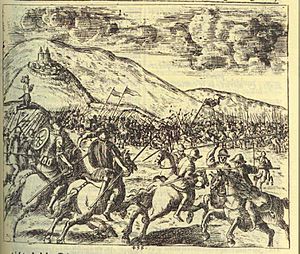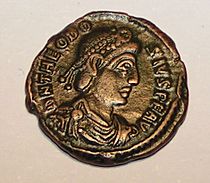Battle of the Frigidus facts for kids
Quick facts for kids Battle of the Frigidus |
|||||||||
|---|---|---|---|---|---|---|---|---|---|
 Battle of the Frigidus by Johann Weikhard von Valvasor (1689) |
|||||||||
|
|||||||||
| Belligerents | |||||||||
| Eastern Roman Empire Visigoths |
Western Roman Empire | ||||||||
| Commanders and leaders | |||||||||
| Theodosius I Timasius Stilicho Alaric Bacurius † Gainas |
Eugenius Arbogast † |
||||||||
| Units involved | |||||||||
| Herculiani seniores | |||||||||
| Strength | |||||||||
| 20,000–30,000 Romans 20,000 Goths |
35,000–50,000, about the same as Eastern Romans | ||||||||
| Casualties and losses | |||||||||
| Heavy 10,000 Goths |
Heavy | ||||||||
The Battle of the Frigidus was a major fight that happened on September 5 and 6, 394 AD. It was between the armies of the Roman emperor Theodosius the Great and a rebel leader named Eugenius. The battle took place near the Frigidus River, likely in what is now Slovenia.
Theodosius won this important battle. His victory helped to unite the Roman Empire again. It also ended the rule of Eugenius and his general, Arbogast.
Theodosius's army was led by generals like Timasius and Stilicho. They also had help from allies like the Goths, led by Alaric. Eugenius's forces were commanded by Arbogast. Arbogast had helped Eugenius become emperor after the mysterious death of Emperor Valentinian II.
This battle was the last major fight involving a Roman emperor who was believed to follow the old Roman gods. However, historians today think Eugenius was not actually a pagan. The idea that he was pagan was spread later to make Theodosius look better. Theodosius was a strong supporter of Nicene Christianity.
Contents
Why the Battle Happened

On May 15, 392, the Western Roman Emperor, Valentinian II, died. He was found dead in his home in Vienne, Gaul. Many people, including Theodosius's wife, thought Valentinian had been murdered.
Arbogast, a powerful general, then made Eugenius the new Western Emperor. Eugenius was a respected scholar. His rule was supported by important officials in Italy. However, some Roman senators were worried about this.
Theodosius, the Eastern Emperor, was not happy. Eugenius had replaced many of Theodosius's officials in the West. This meant Theodosius had lost control. When Eugenius's messengers asked Theodosius to accept him as emperor, Theodosius did not give a clear answer.
In January 393, Theodosius declared his own young son, Honorius, as the Western Emperor. This showed he was ready to fight Eugenius and Arbogast.
Getting Ready for War
Over the next year and a half, Theodosius prepared his army. The Eastern Roman army had become weaker over time. Generals Flavius Stilicho and Timasius worked hard to train the soldiers. They also recruited new fighters.
An advisor to Theodosius, named Eutropius, visited a Christian monk in Egypt. The monk told Eutropius that Theodosius would win the battle. He said it would be a difficult but clear victory.
The Eastern army began its march in May 394. It included many non-Roman soldiers, like over 20,000 Visigoth fighters. Theodosius led the army himself. His commanders included Stilicho, Timasius, the Visigoth leader Alaric, and a general from Caucasian Iberia named Bacurios Hiberios.
Theodosius's army marched through the Julian Alps without any problems. They were surprised that the mountain passes were not guarded. Arbogast had decided to keep his forces together to defend Italy itself. He left the mountain passes open.
Because of Arbogast's plan, Theodosius's army passed through the Alps easily. They came down into the valley of the Frigidus River. This was east of the Roman city of Aquileia. Here, in this narrow, mountainous area, they found the Western army's camp. This happened in early September.
The Battle Begins
It's not exactly clear where the battle took place. Most historians believe it was in the Vipava Valley in Slovenia. The Frigidus River is thought to be the modern Vipava River. Some recent studies suggest it was between Col and Sanabor.
Before the battle, Eugenius and Arbogast placed a statue of the Roman god Jupiter on the battlefield. They also put images of Hercules on their army flags. They hoped this would bring them victory, like in old Roman times when people believed the gods helped them.
On the first day of fighting, it seemed the old gods were helping Eugenius. Theodosius attacked quickly without checking the battlefield first. He sent his Gothic allies into the fight first. This attack led to many deaths. About 10,000 Gothic soldiers were killed. The Georgian general Bacurius also died.
By the end of the day, Eugenius was celebrating his army's success. Arbogast sent groups of soldiers to block the mountain passes behind Theodosius's army. He wanted to trap them.
The Turning Point
After a night without sleep, Theodosius received good news. The soldiers Arbogast had sent to block the passes were planning to switch sides and join Theodosius. This news made Theodosius and his men feel much better.
Theodosius's army attacked again. This time, nature helped them. A very strong wind, called the bora, blew down the valley from the east. This wind is common in that area.
Stories say that Theodosius prayed to God for a storm, and God answered his prayer. The strong winds blew dust into the faces of the Western troops. Legend also says the wind blew the Western soldiers' own arrows back at them.
The wind made it very hard for Arbogast's army to fight. Their lines broke apart, and Theodosius won a clear victory. This was the victory the Egyptian monk had predicted.
After the battle, Eugenius was captured. He was brought before Theodosius and then executed. Arbogast tried to escape but was later found and took his own life.
What Happened After
Theodosius won, but it was a costly victory. Many soldiers died, especially the Goths. Some historians even say Theodosius won two battles: one against Eugenius and one against the Goths.
Just four months after the battle, Theodosius died. He left the Roman Empire to his young sons, Honorius and Arcadius.
The Battle of the Frigidus also weakened the Roman army in the West. The many losses meant the Empire had to rely more on non-Roman fighters. These fighters were often paid mercenaries, and they were not always reliable.
Sources
Secondary sources
- Kahlos, Maijastina (2019). [Battle of the Frigidus at Google Books Religious Dissent in Late Antiquity, 350–450]. Oxford University Press. ISBN 978-0-19-006725-0. Battle of the Frigidus at Google Books.
See also
 In Spanish: Batalla del Frígido para niños
In Spanish: Batalla del Frígido para niños




